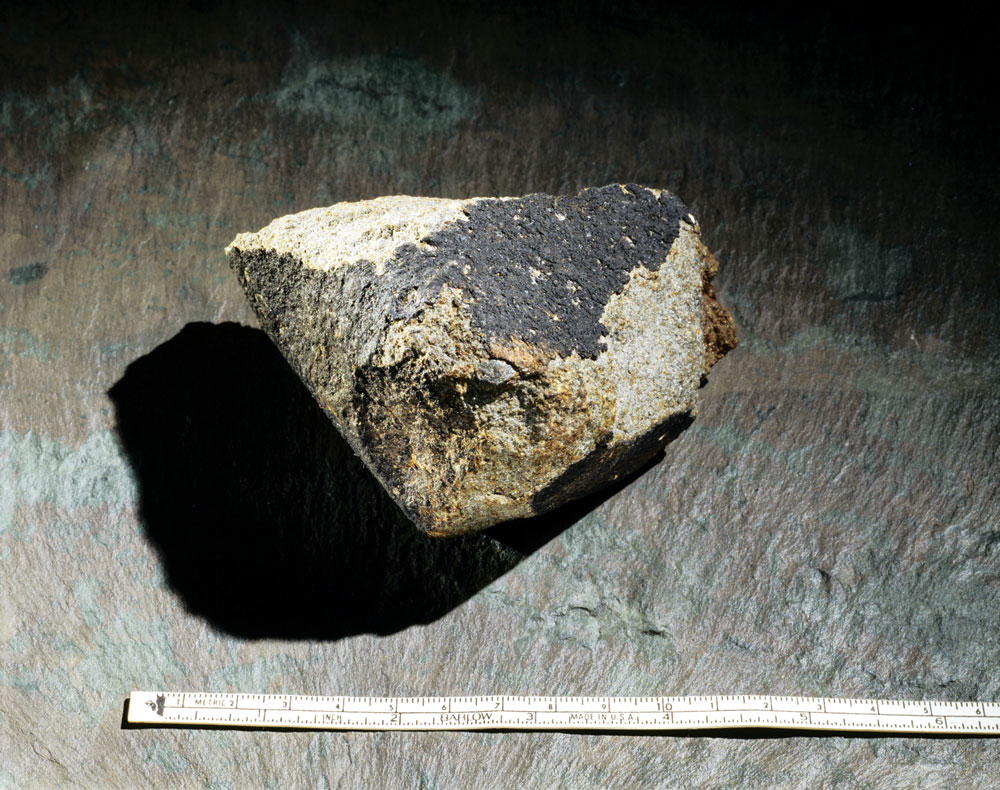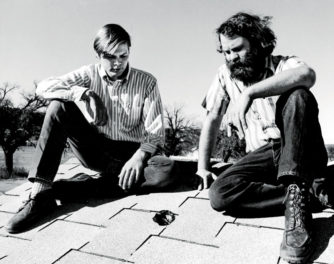
This is the famous Cañon City meteorite that measures about 3” across. Some of the black fusion crust broke off when it hit the floor. All images courtesy of Denver Museum of Nature and Science (DMNS).
The oldest thing in Colorado is more ancient than Earth itself. It’s a meteorite.
Meteorites are hunks of rock that don’t completely burn up as they hurtle through our atmosphere. Unlike most Earth rocks, they’re composed of an odd mix of metals and minerals. They have a burnt appearance—like a well-seasoned cast iron pan. This so-called “fusion crust” forms as they’re scorched on their descent.
All of us have seen meteors fall … or at least microscopic ones. That’s because shooting stars are mostly dust- to sand-size meteors that burn up as they enter our atmosphere. Millions of these meteors as well as larger ones bombard Earth every day. Scant few are big enough to survive entry and make it down to the surface as a meteorite.
Most meteorites originate as bits of debris that were bounced out of the asteroid belt betwixt Mars and Jupiter. Most of them are older than any Earth rocks, because most ancient Earth rocks have long been worn down or recycled by mother nature. Formed four and a half billion years ago during the accretion of our sun and its planets, most meteorites spend an eternity in the sterile vacuum of outer space. There, they’re protected from the unforgiving elements that break rocks down on our planet’s surface.
But the rarest meteorites originated as debris that was ejected off the surface of the moon or Mars when huge meteors collided with them. Before these lunar and Martian castaways fell to Earth, they journeyed through space like drunken billiard balls. Sometimes they drifted for tens of millions of years before they became trapped by our gravitational field. All told, there are about a hundred known meteorites from the moon and even fewer from Mars.

DMNS curators Jack Murphy (left) and Don Lindsey in 1973 examine the hole where a meteorite entered a Cañon City garage. The meteorite was traveling 200 mph when it hit (as compared to hail at 20 mph).
With all this space junk raining down, should we worry for our safety? After all, the dinosaurs bit the dust due to a Greeley-sized meteorite. Fortunately, the chances of being struck by a meteorite are lower than winning Powerball. But meteorites occasionally do hit buildings, roads and the like. In 1973, one plunged right through someone’s garage in Cañon City. Hitting at over 200 mph, it made our hailstones (at up to 20 mph) seem insignificant.

Colorado’s got plenty of meteorites. In part that’s because people have been picking them up for millennia. Native Americans traded meteorites long before Spaniards ever set foot here. Puebloans, Pawnee and other tribes used, worshipped, and in some cases feared these metallic stones that fell from the sky. During Colorado’s Gold Rush, one prospector dug up a rusty meteorite thinking it might lead to riches. Talk about fool’s gold.
Colorado was the first place meteorites were seriously studied in the United States. In the 1930s, ex-biologist and meteorite-hunter Harvey Nininger built the world’s most comprehensive meteorite collection at the Denver Museum of Nature & Science. Four books and over 150 scientific papers later, he became revered as the father of modern meteoritics.
Even larger collections of meteorites are being assembled today, because meteorites provide clues from deep time about how our planets formed, and even life itself. For example, Martian meteorites come from all over Mars’ surface, in contrast to the mere half-dozen places where spacecraft have landed. Thus, they extend our knowledge of the planet’s geology, providing clues about both ancient Mars and present-day conditions there. Ditto for lunar meteorites and our Moon.
And the very oldest meteorites? These ones contain microscopic blebs that trapped the gases and dust that later congealed into our sun and its planets. Others contain primitive compounds, amino acids, and carbon that subsequently became the building blocks of life as we know it. Now that’s primordial!
Meteorites are also cost-effective. It costs a lot less to find and study a meteorite than to send a rover to Mars or the Moon. So meteorites, including those from Colorado, are an efficient way to explore space and time without getting too far away from Starbucks. Not to mention that when you cut ’em open, they’re often beautiful. Today, meteorites are prized by collectors, both for their rarity and their beauty.
Think you’ve found a meteorite? Most meteorites have more nickel and iron in them than do common earth rocks, making them able to attract a magnet. But unlike most earth rocks, meteorites lack visible quartz—the common silica-based mineral that makes up most beach sands and glass. Plus, they have a fusion crust.
Don’t worry if you’ve found a piece of slag, the waste from smelting steel. It’s a close cousin of a meteorite, known as a “meteorwrong.”
James Hagadorn, Ph.D., is a scientist at the Denver Museum of Nature & Science. Suggestions and comments are welcome at jwhagadorn@dmns.org.



0 Comments